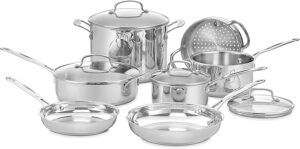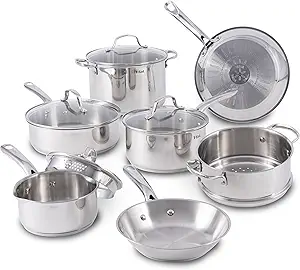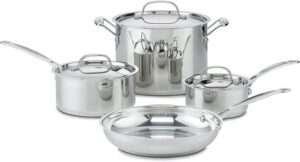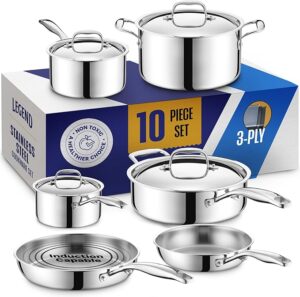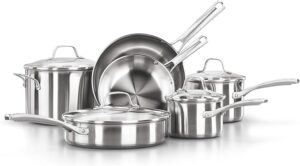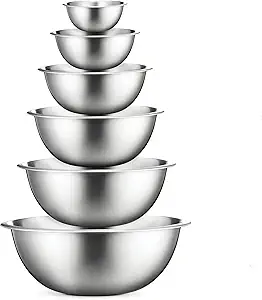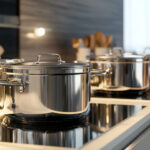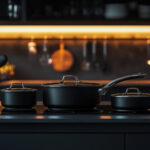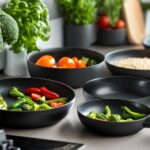Are Stainless Steel Cookware Still Popular in 2025? The Pros and Cons
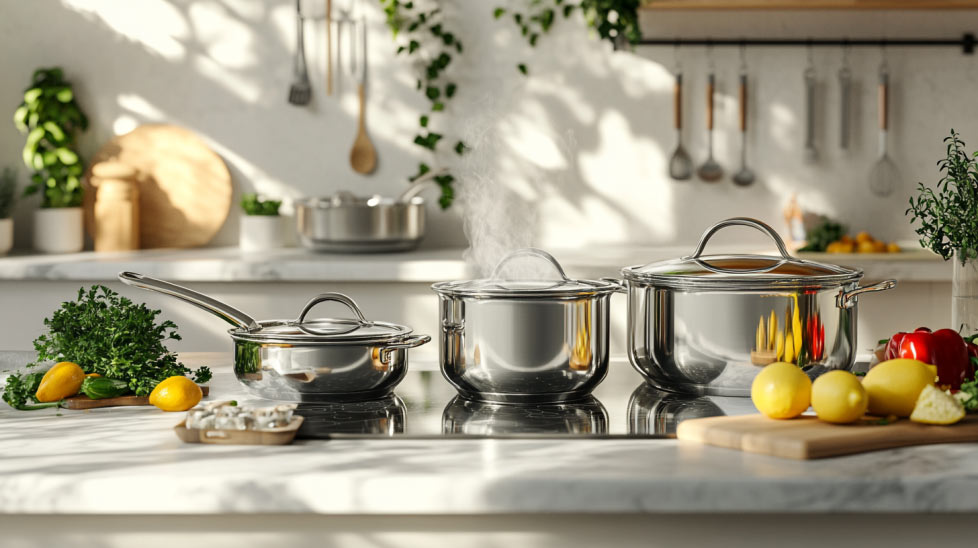
Introduction: Is Stainless Steel Cookware Still a Popular Choice in 2025?
Stainless steel cookware has long been a kitchen staple, celebrated for its durability, versatility, and sleek design. But with a growing array of new materials like non-stick coatings, cast iron, and ceramic cookware gaining attention, many are wondering if stainless steel still holds its ground in 2025.
As we step into this new era of culinary trends, it’s important to evaluate whether stainless steel remains the go-to choice for both professional chefs and home cooks. This article will explore the reasons behind its continued popularity, the advantages it offers over newer alternatives, and why it remains a top contender in kitchens worldwide today.
The Durability of Stainless Steel Cookware in 2025
One of the standout features of stainless steel cookware is its remarkable durability, a quality that has stood the test of time. In 2025, this remains one of the primary reasons why chefs and home cooks alike continue to choose stainless steel. Unlike other materials that can wear down, scratch, or degrade over time, stainless steel is known for its ability to withstand high temperatures, heavy use, and years of consistent cooking without losing its shape or effectiveness.
Modern advancements in stainless steel manufacturing have only enhanced its durability. Multi-ply stainless steel, often made with layers of aluminum or copper, provides better heat distribution and resistance to warping, making it more reliable than ever. Whether you’re sautéing, simmering, or searing, stainless steel cookware can handle it all, ensuring it stays in excellent condition for many years.
This durability is also reflected in its resistance to rust and corrosion, meaning that stainless steel pots and pans won’t easily degrade, even after exposure to acidic foods or extensive washing. For those looking for a lasting investment in their kitchen, stainless steel continues to be one of the best options.
Advantages of Stainless Steel Cookware in 2025
Stainless steel cookware remains a popular choice in 2025 due to its numerous advantages that cater to both functionality and style in the kitchen. Here are some of the top benefits that make stainless steel a standout option:
Tefal Pans: Aluminum, Stainless Steel, or Cast Iron – Which Is Best for Your Kitchen?
- Longevity and Reliability: As mentioned earlier, stainless steel cookware is incredibly durable, with the potential to last for decades when properly cared for. This long lifespan makes it a wise investment, offering consistent performance without the need for frequent replacements.
- Non-Reactive Surface: Stainless steel is non-reactive, meaning it won’t alter the flavor of acidic foods like tomatoes or vinegar. This is a crucial advantage over other materials like aluminum or cast iron, which can impart unwanted tastes or cause discoloration when cooking certain ingredients.
- Easy to Maintain: Cleaning and maintaining stainless steel cookware is relatively simple. Unlike non-stick pans, which can degrade over time or require special care, stainless steel retains its appearance with minimal effort. A quick scrub with mild soap and water is usually enough to remove stains, and most pieces are dishwasher safe for added convenience.
- Versatility: Stainless steel cookware is compatible with all types of stovetops, including induction, gas, and electric. It can also be used in the oven, making it a versatile tool for all kinds of cooking techniques, from stovetop searing to oven baking.
- Sleek and Modern Appearance: The shiny, polished finish of stainless steel brings an elegant, professional look to any kitchen. It’s easy to pair with other kitchen tools and décor, ensuring it fits seamlessly into both traditional and contemporary kitchen styles.
- Healthier Cooking: Since stainless steel doesn’t require the use of oils or coatings like non-stick pans, it can promote healthier cooking. It also avoids the potential health risks associated with chemical coatings that can break down over time.
These advantages combine to keep stainless steel at the top of the list for anyone seeking cookware that balances durability, performance, and aesthetics, making it a solid choice well into 2025.
Disadvantages of Stainless Steel Cookware in 2025
While stainless steel cookware offers many benefits, there are a few drawbacks to consider, especially as new cookware materials continue to emerge. Here are some of the main disadvantages of stainless steel cookware in 2025:
We also recommend you to read: Tefal Cookware Trends in 2025: Innovations and Features You Need to Know
- Poor Heat Conductivity (Without Proper Layering): Pure stainless steel can have poor heat conductivity, meaning it might take longer to heat up and could result in uneven cooking. This is why many high-quality stainless steel pots and pans are made with an aluminum or copper core, which improves heat distribution. Without these added layers, cooking on stainless steel may not be as efficient as with materials that heat up more quickly and evenly.
- Weight: Stainless steel cookware can be heavy, especially with multi-ply construction or large pans. For some users, the weight may make cooking more challenging, particularly when trying to maneuver larger pots or move them in and out of the oven. While heavier cookware is often a sign of quality, it can be a disadvantage for those seeking lighter, easier-to-handle options.
- Prone to Staining and Discoloration: Though stainless steel is durable, it can still show stains or discoloration over time, especially when exposed to high heat or acidic foods. While the stains don’t affect the functionality of the cookware, they can detract from its aesthetic appeal. In many cases, these can be removed with the right cleaning techniques, but it’s something to keep in mind.
- Lack of Non-Stick Properties: Unlike non-stick cookware, stainless steel requires careful attention when cooking delicate foods like eggs or fish. Without a coating to prevent sticking, it may take a bit more effort to properly sauté or fry certain foods, and cleanup can be more involved compared to non-stick alternatives.
- Cost: High-quality stainless steel cookware can be expensive, especially if it features additional layers like copper or aluminum. For those on a budget, it may be harder to justify the higher upfront cost compared to more affordable alternatives like non-stick or cast iron cookware. However, the investment often pays off in terms of longevity and performance.
Despite these drawbacks, many find that the advantages of stainless steel cookware outweigh the disadvantages, especially with proper care and the right technique. However, it’s important to consider these factors when choosing the right cookware for your needs in 2025.
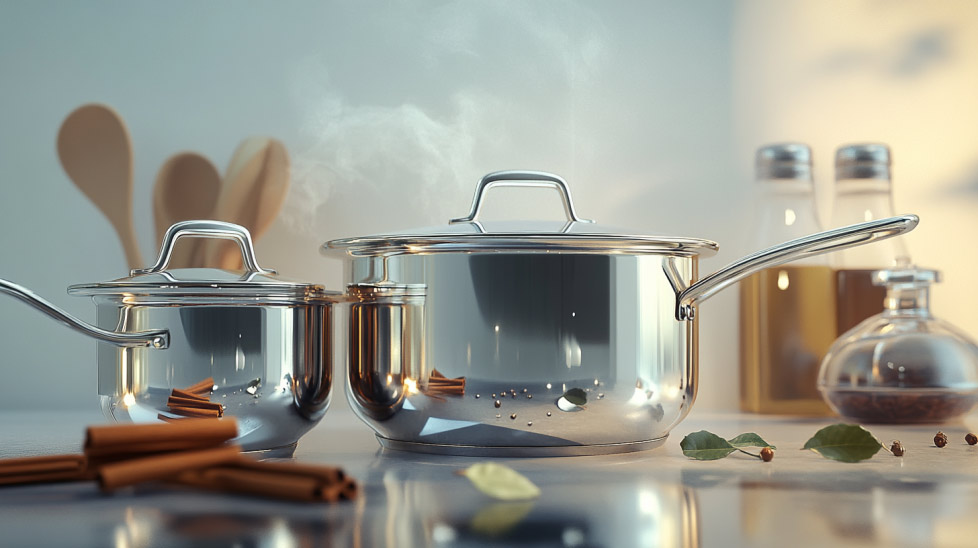
Stainless Steel vs Other Cookware Materials in 2025
When choosing cookware, stainless steel isn’t the only option. Other materials like non-stick, cast iron, copper, and aluminum each have their own distinct advantages and challenges. However, in 2025, stainless steel continues to hold its ground, standing out for its durability and versatility.
Non-stick cookware is often preferred for its convenience, especially when cooking delicate foods like eggs or fish. Its smooth surface reduces sticking, making it easier to cook and clean. However, over time, non-stick coatings can degrade, especially under high heat, and the materials used in the coating have raised health concerns. Stainless steel, on the other hand, offers a more durable, non-reactive surface that does not impart any flavors to food. While it requires more care to prevent sticking, it’s a safer, long-lasting option that doesn’t come with the same health risks.
Cast iron, renowned for its excellent heat retention, excels in slow cooking and searing. It’s particularly favored for dishes that require even heat distribution over long periods. However, it’s much heavier than stainless steel, making it harder to maneuver, especially when dealing with large pots or pans. Additionally, cast iron requires more maintenance, including seasoning to prevent rust. Stainless steel offers the best of both worlds: it heats quickly, is easier to handle, and requires minimal maintenance, making it a preferred choice for busy kitchens.
Copper cookware is prized for its superior heat conductivity, allowing for precise temperature control. It heats up and cools down quickly, which is ideal for delicate dishes. While copper has undeniable aesthetic appeal, it’s also more expensive and requires extra care, including regular polishing to maintain its shine. Stainless steel, while not as quick to heat, often features a copper or aluminum core to improve heat distribution. It provides a similar level of precision but at a more affordable price and with less maintenance.
Aluminum, like copper, is an excellent heat conductor, making it a good choice for fast cooking. However, aluminum pans can react with acidic foods, which may alter the taste and cause the material to degrade. Many aluminum pans are now anodized or coated to prevent these issues, but stainless steel’s non-reactive properties make it a safer and more durable option. Additionally, stainless steel is more resistant to damage, offering a longer lifespan than aluminum, which is prone to warping and scratching.
In summary, while each material has its own strengths, stainless steel remains the most balanced option for most kitchens in 2025. It combines durability, health benefits, and low maintenance, making it an enduring favorite. Its versatility in handling different cooking techniques and compatibility with all stovetops and ovens continue to make it a top choice for both professional chefs and home cooks alike.
Is HexClad Pfanne Oven Safe? A Complete Guide for 2025
Why Stainless Steel Cookware Still Holds Its Ground in 2025
Stainless steel cookware remains a top choice in 2025 due to its durability, versatility, and safety. Its long lifespan means it can withstand years of heavy use without losing its effectiveness, making it a smart investment. Modern stainless steel now features multi-ply construction, with layers of aluminum or copper that improve heat conductivity, addressing past issues of uneven cooking.
In addition to being durable, stainless steel is non-reactive, ensuring it won’t alter the taste of food or release harmful chemicals. Unlike non-stick cookware, it doesn’t require special care or seasoning, making it low-maintenance. Stainless steel is also highly versatile, working on all stovetops, including induction, and is oven-safe, perfect for various cooking methods.
The sleek, shiny appearance of stainless steel adds an elegant touch to any kitchen, making it both functional and visually appealing. Plus, it’s an eco-friendly option since it’s fully recyclable, aligning with sustainability trends. These factors combine to keep stainless steel cookware a popular choice, offering reliable performance and lasting value in 2025 and beyond.
Are Stainless Steel Cookware Worth the Investment in 2025?
Stainless steel cookware continues to be a valuable investment in 2025, thanks to its blend of durability, performance, and timeless appeal. While it may come with a higher upfront cost compared to alternatives like non-stick or aluminum pans, its long lifespan and versatility make it a cost-effective choice in the long run. Unlike non-stick cookware, which can degrade over time and needs to be replaced, stainless steel remains reliable and effective for years, making it a smart choice for those looking for cookware that will stand the test of time.
Moreover, stainless steel’s multi-ply construction ensures better heat distribution and durability, which enhances cooking efficiency. Its non-reactive surface means it won’t alter the taste of your food, offering a safer and healthier cooking experience. And with minimal maintenance required, stainless steel is a low-hassle option that doesn’t demand the same level of care as cast iron or non-stick cookware.
Given its versatility—working on all stovetops, in the oven, and under high heat—stainless steel cookware can handle a wide range of cooking techniques, making it a must-have for anyone serious about cooking. Additionally, the sleek, modern appearance ensures it remains a beautiful and functional addition to your kitchen.
Considering all these factors, stainless steel cookware proves to be a worthwhile investment in 2025, offering both practical benefits and lasting value.
Conclusion: Should You Choose Stainless Steel Cookware in 2025?
In 2025, stainless steel cookware continues to be a top contender for anyone looking for durable, versatile, and reliable kitchen essentials. While it may come with a higher initial cost compared to other options, its long lifespan, excellent heat distribution, and low-maintenance nature make it a wise investment for the long haul. Its non-reactive surface ensures safe, healthy cooking, and its ability to withstand high heat means it can handle virtually any cooking technique with ease.
Whether you’re a seasoned chef or a home cook, stainless steel cookware offers unmatched performance and aesthetic appeal. Its versatility across all stovetops and in the oven, combined with its eco-friendly properties, make it a solid choice for anyone looking to equip their kitchen with high-quality tools that last.
So, if you’re looking for cookware that will not only meet your needs in 2025 but continue to serve you well for many years to come, stainless steel is a choice worth making.

